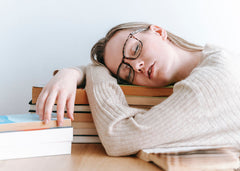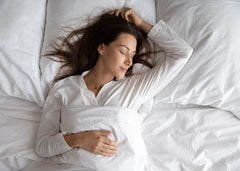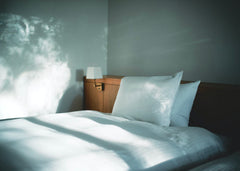Have you noticed anyone in your home get up and wander around at night while they’re still asleep? They could be among the 4% of adults who experience sleepwalking - a sleep disorder that can affect both children and adults.
If you’ve witnessed sleepwalking, you’ll probably understand the confusion and worries it can cause. But what is really happening, and is it dangerous? Let’s explore this common sleep issue and share tips to create a safer, more relaxing sleep environment to alleviate concerns and reduce potential risks.

What Exactly is Sleepwalking?
Sleepwalking, officially known as somnambulism, is a sleep disorder where a person leaves their bed and moves around while in a state of deep sleep (specifically, the non-rapid eye movement, NREM stage). They might:
- Sit up in bed and look around
- Walk around the home
- Perform complex activities like getting dressed or making food
- Talk or have their eyes open with a "glassy" look
Since it happens during deep sleep, the sleepwalker typically has no memory of their actions the next day. While it's more common in children (up to 15% of children), adults can experience it too, and that’s when creating a safe environment becomes critical.

What Triggers a Sleepwalking Episode?
There isn't one single cause, but sleep experts have identified several key triggers that can increase the likelihood of sleepwalking. Understanding these is the first step in prevention.
- Genetics: If it runs in your family, you're more likely to experience it.
- Stress & Anxiety: A racing mind often creates trouble settling into restorative sleep. This is why creating a calm, relaxing bedroom sanctuary is your first line of defence against all kinds of sleep disruptions.
- Sleep Deprivation: Are you tossing and turning all night? If you’re not getting enough sleep, or if your bed is deteriorating resulting in poor quality sleep, your chances of sleepwalking are increased.
- Sleep Apnoea: People with sleep apnoea often wake up briefly throughout the night to breathe, which can trigger a sleepwalking state. Elevating the head can open airways and reduce apnoea events.
- Medications or Alcohol: Certain medications or alcohol can disrupt normal sleep cycles.

The Hidden Hazards: Is Sleepwalking Dangerous?
The act of sleepwalking itself isn't dangerous, but the risk of accidents happening is very real. As the conscious part of the brain is asleep, the sleepwalker is unaware of their surroundings, which can lead to:
- Tripping and falling over furniture
- Hurting themselves while trying to cook or using sharp objects
- Wandering outside the home
These are some of the reasons why creating a "safe sleep zone" is paramount for anyone living with a sleepwalker.
What Should You Do if You See Someone Sleepwalking?
You may have heard the myth that waking up a sleepwalker can cause a heart attack - it's not true. However, waking them suddenly can cause intense confusion, fear, and disorientation.
The best approach is to gently guide them back to bed without waking them up. If it is absolutely necessary to wake them up, use a loud, sharp noise from a distance rather than shaking them directly.
A 4-Step Plan for a Safer Sleep Haven
While you can't cure a genetic predisposition, you can significantly reduce the triggers and dangers of sleepwalking by optimising your sleep environment.
1. Keep a regular sleep schedule: A consistent bedtime and wake-up time is the foundation of a good sleep routine.
2. Create a wind down routine before sleep: Relax and wind down for 30 minutes before bed. Dim the lights, practise gentle yoga, or sip a cup of herbal tea. This signals your brain that it's time to rest.
3. Ensure your room is cool, dark and quiet: These are the three components that create an ideal sleep environment. A cool room promotes deeper sleep.

➡️ Explore breathable Bamboo Sheets and cooling Gel Memory Foam Pillows to help regulate temperature all night long.
4. Invest in a comfortable and safe sleep surface: Your bed is the heart of a restful sleep experience. The perfect combination doesn’t just feel good - it can actively reduce triggers that induce sleepwalking.
- For bed discomfort and partner disturbance: If you're using an uncomfortable mattress or are frequently being woken up by a partner who tosses and turns, your sleep is being compromised. Consider using a mattress with excellent motion isolation and pressure relief properties.
- For sleep apnoea & acid reflux: These conditions fragment sleep. An adjustable bed base allows you to sleep with your head elevated, opening airways and reducing triggers.
- For overall safety: Consider using a bed frame with a lower height to reduce the risk of injury from a fall.

Ready to build a foundation for safer sleep?
Understanding sleepwalking is the first step, and taking action is next. A suitable mattress is your most powerful tool for creating a safe, serene environment that encourages deep, restorative sleep.
➡️ Read more on how to find the perfect mattress for you!




